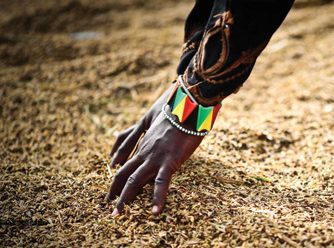
By Lee Anna Sherman
Siberia seldom tempts Western travelers to explore its vast taiga forests and endless permafrost — unless that traveler happens to be Allison Stringer. For the OSU biology student, nothing could be more enticing than spending a summer month “out in the middle of nowhere”— living on a barge at the Northeast Science Station near a tiny town called Chersky, discovering the long-buried bones of mammoths and ancient bison in the eroded banks of a nearby river, measuring tree rings with a high-powered microscope and recording carbon levels in soils to gauge the impact of climate change on Arctic ecosystems.
“Preliminary findings show a general pattern of slowing growth rates in trees,” Stringer reports. “The hypothesis is that as temperatures increase and permafrost thaws, the water table drops and drops and drops, eventually dropping below where trees have roots.”
Not every college sophomore would be in her element in such a primitive place with few amenities and even fewer hours of darkness in midsummer. But as a kid growing up in Missoula, Montana, this was a girl who liked frogs more than Barbies, who preferred wildflowers to princesses, and who reveled in the Big Sky landscapes where she camped and fished with her family.
She didn’t wait around to start her career in research. As a high school senior, she worked with a biologist at Lee Metcalf National Wildlife Refuge to monitor stream temperatures with electronic sensors that logged the data hourly. The water in many parts of the refuge, she discovered, was too warm to support native trout. She wrote “a big old paper,” won a bunch of awards, and traveled to Salt Lake City, Colorado Springs and Anchorage to present her poster.
She hasn’t shifted gears since coming to Oregon State, where she continues her full-throttle approach to life and learning as a member of the University Honors College. Besides majoring in biology with the “Marine Biology Option” (extra coursework), she also has a major in fisheries and wildlife and a minor in Spanish. But that’s only the basic framework. Like a zealous tourist who’s determined to fit every last item of clothing into her suitcase, even if it means sitting on the bag to get it latched, Allison Stringer is cramming into her college education every shred of experience she possibly can.
Russian in Her Spare Time
That means studying conservation and rural policymaking in Chile at the Universidad Austral de Chile with fisheries professor Dan Edge (“I do have a travel bug,” she admits). It means investigating nutrient cycling in the H.J. Andrews Experimental Forest with forestry professor Mark Harmon (“It’s a good opportunity to learn statistics and basic mathematical modeling,” she notes). It means working toward her “dive master” scuba certification with a grant from the Oregon Chapter of the American Fisheries Society (“I applied for so many random grants!” she confesses), plus being a diver-in-training for “scientific diver” certification — all in preparation to study lionfish in the Bahamas this summer with famed reef ecologist Mark Hixon. Oh, and she’s taking a non-credit course in Russian after learning a bit of the language out in Siberia. In her spare time.
Spanish and Russian, lionfish and permafrost, tree rings and native trout, Siberian tundra and Bahamian reefs: What ties these disparate threads together?
“Broadly, it’s ecology and ecosystems,” Stringer explains. “Underlying everything I do is wanting to give back to the world — to leave the world a better place than it was before. Right now, everything is overharvested, overused. But there’s still hope. I’d like to be that hope.”
_________________
Editor’s note: Allison Stringer received the CHS Foundation Scholarship and other awards.




